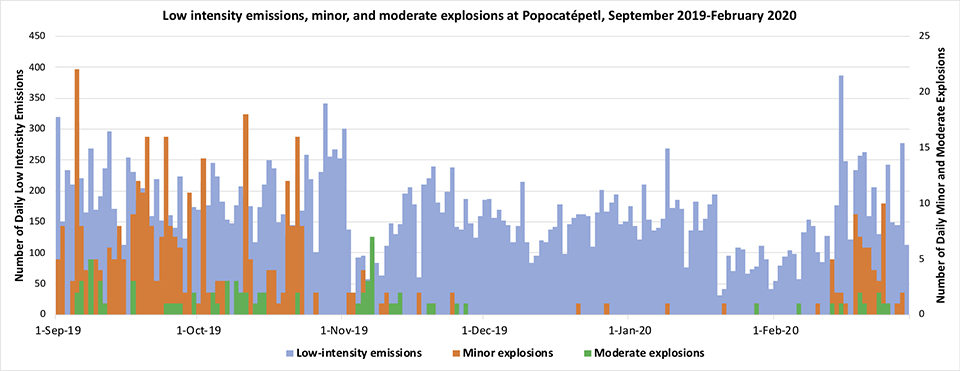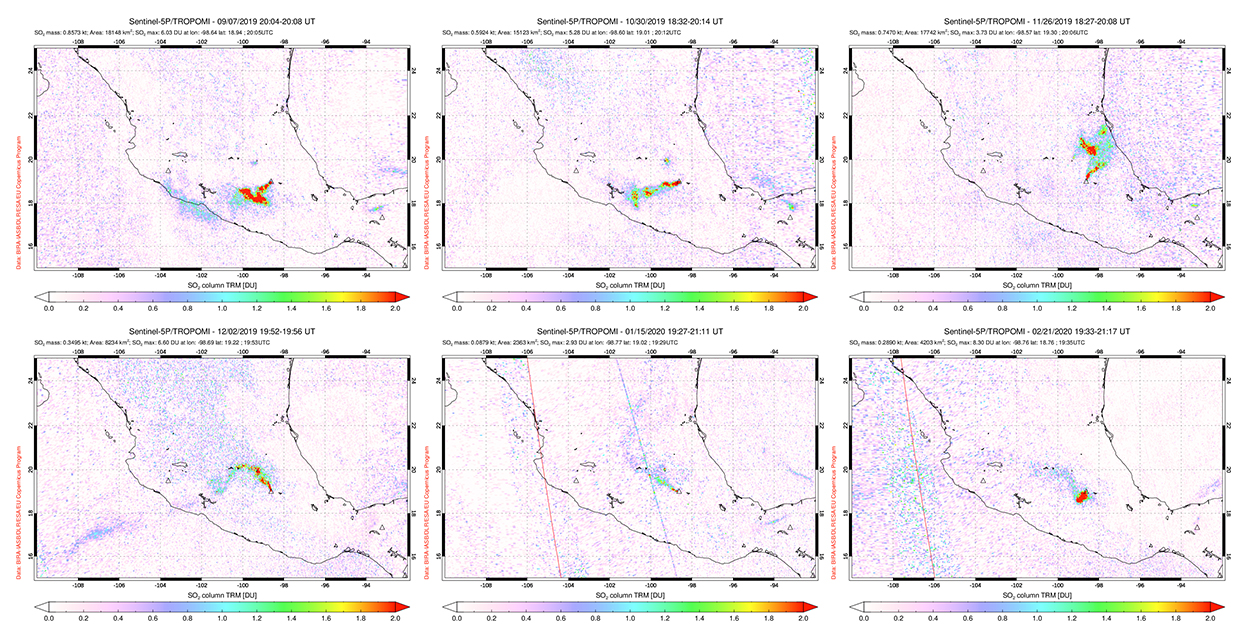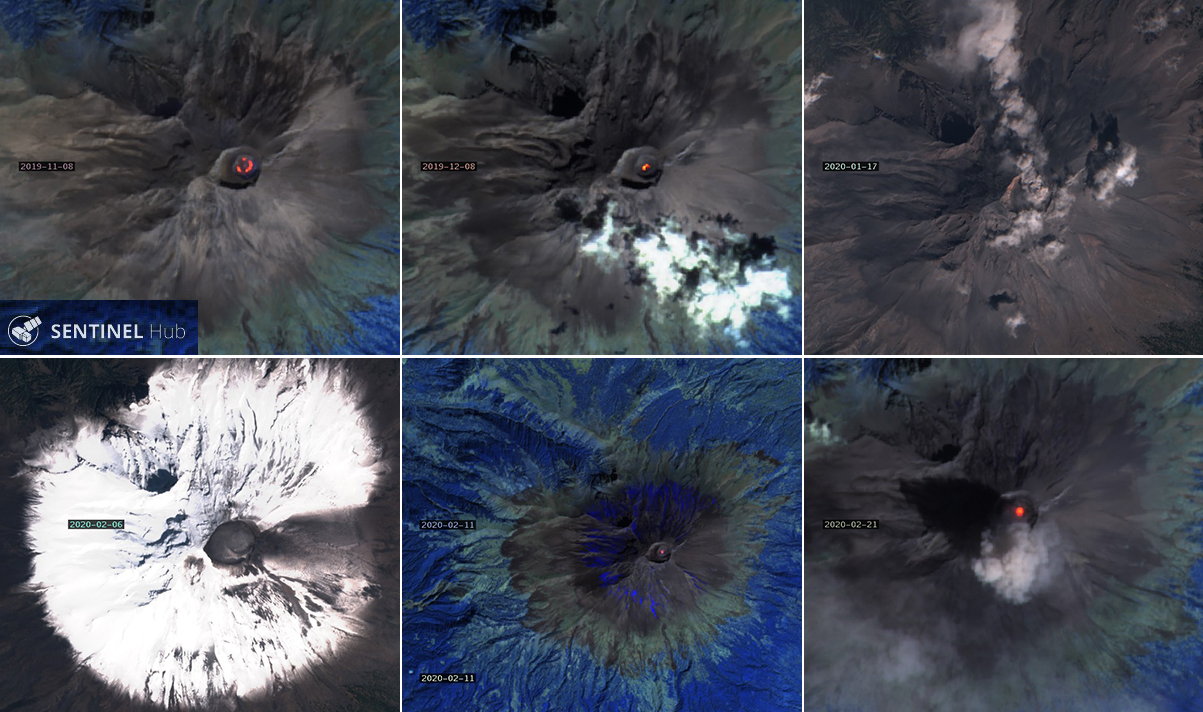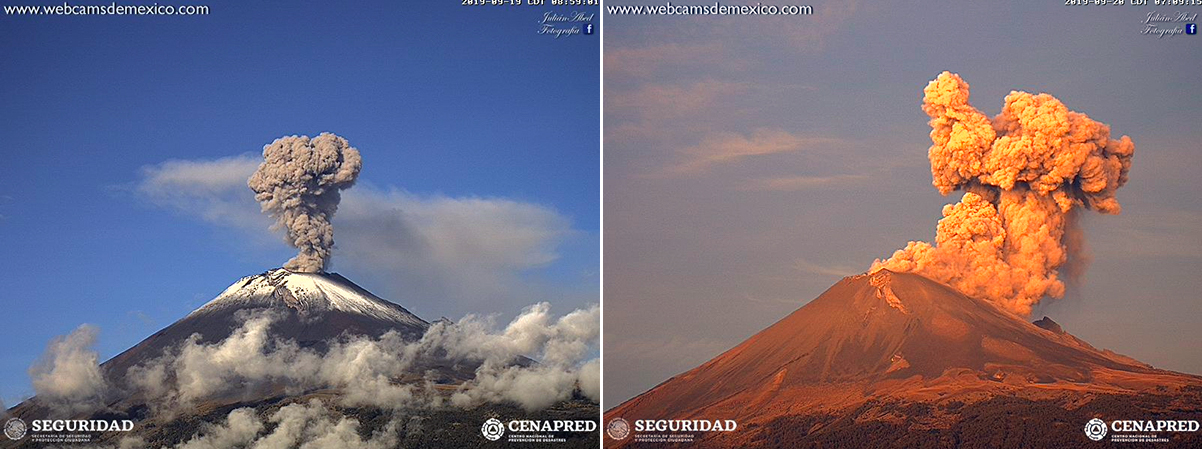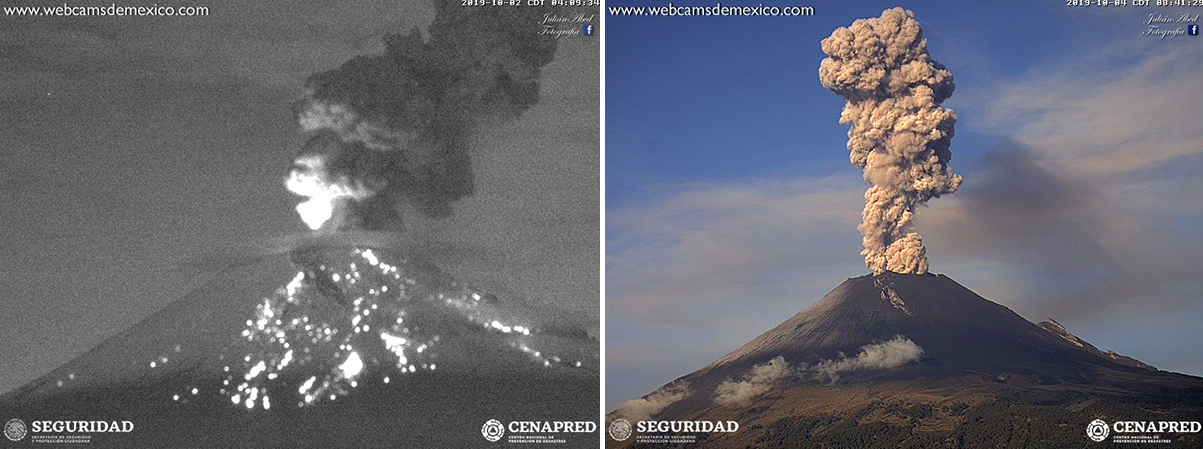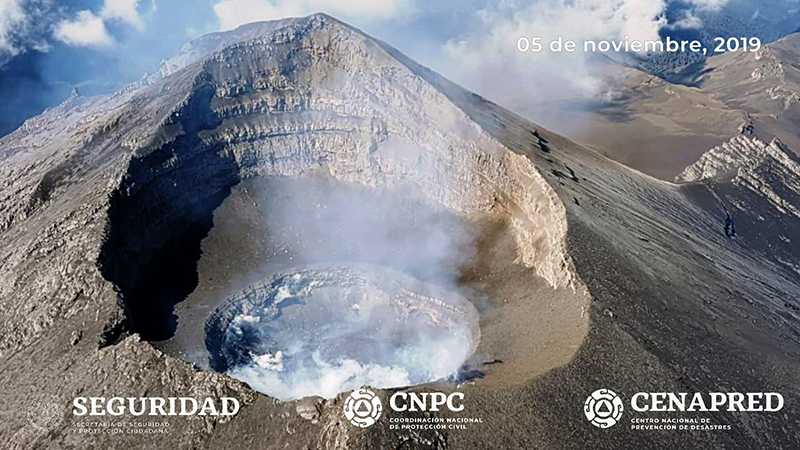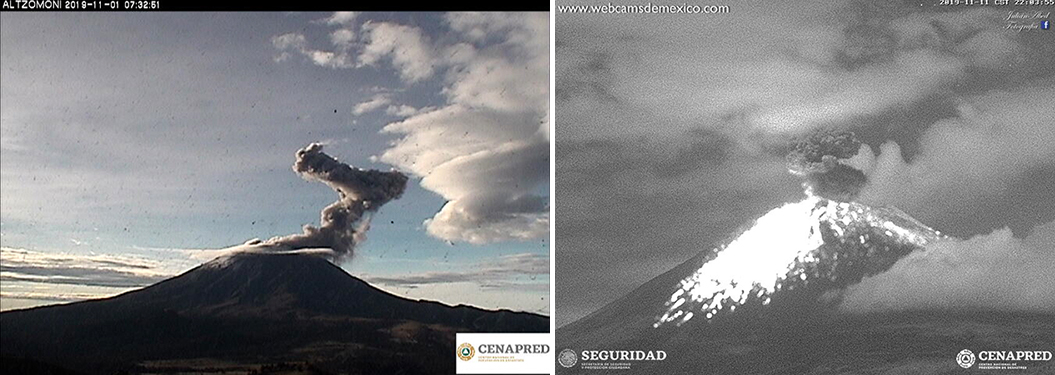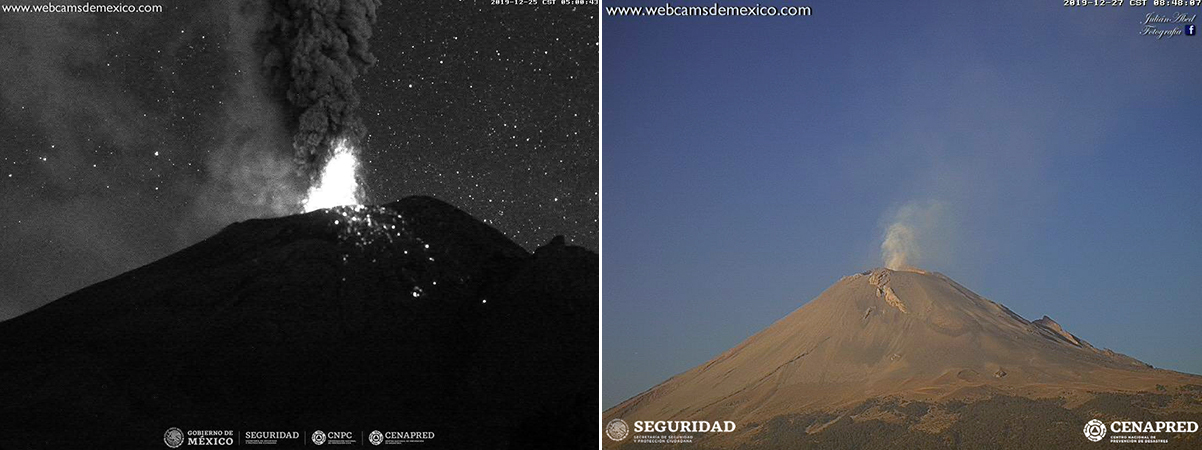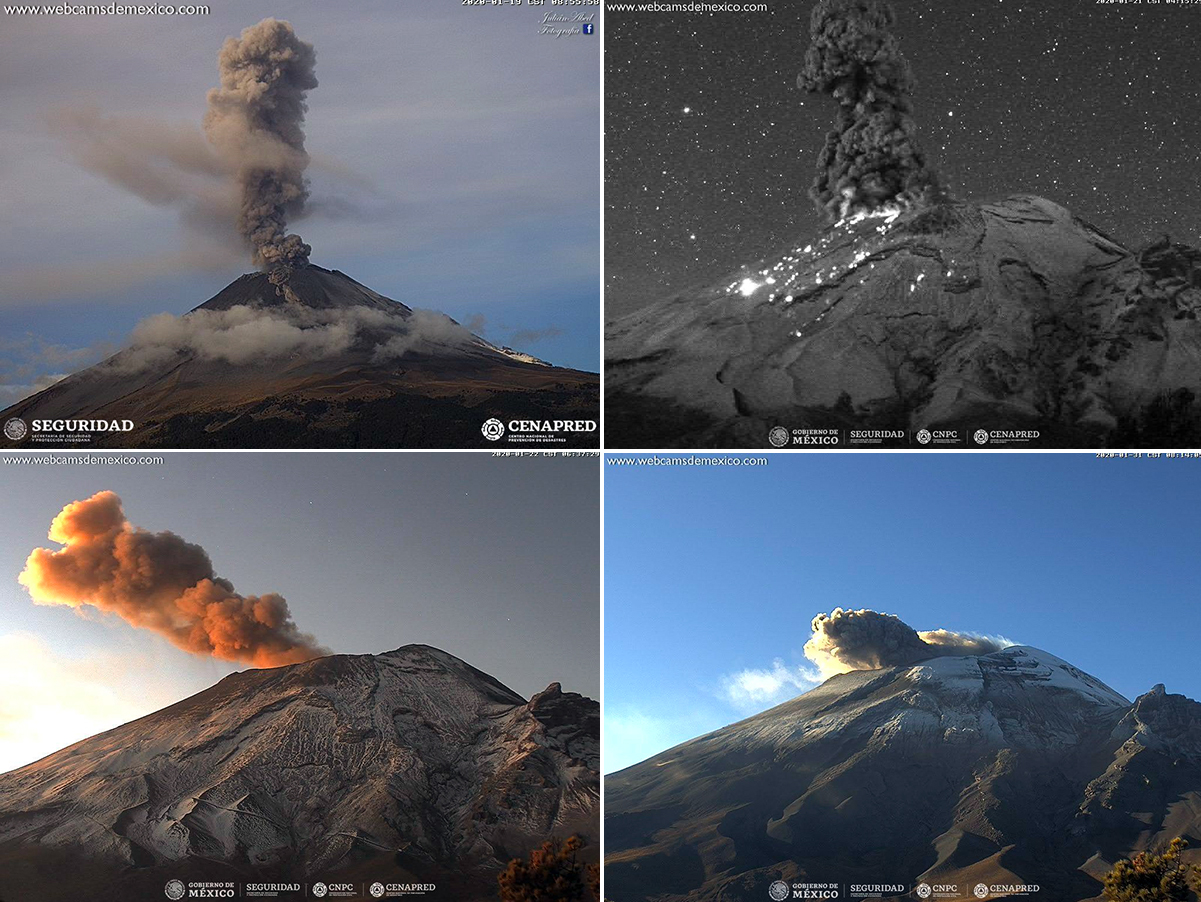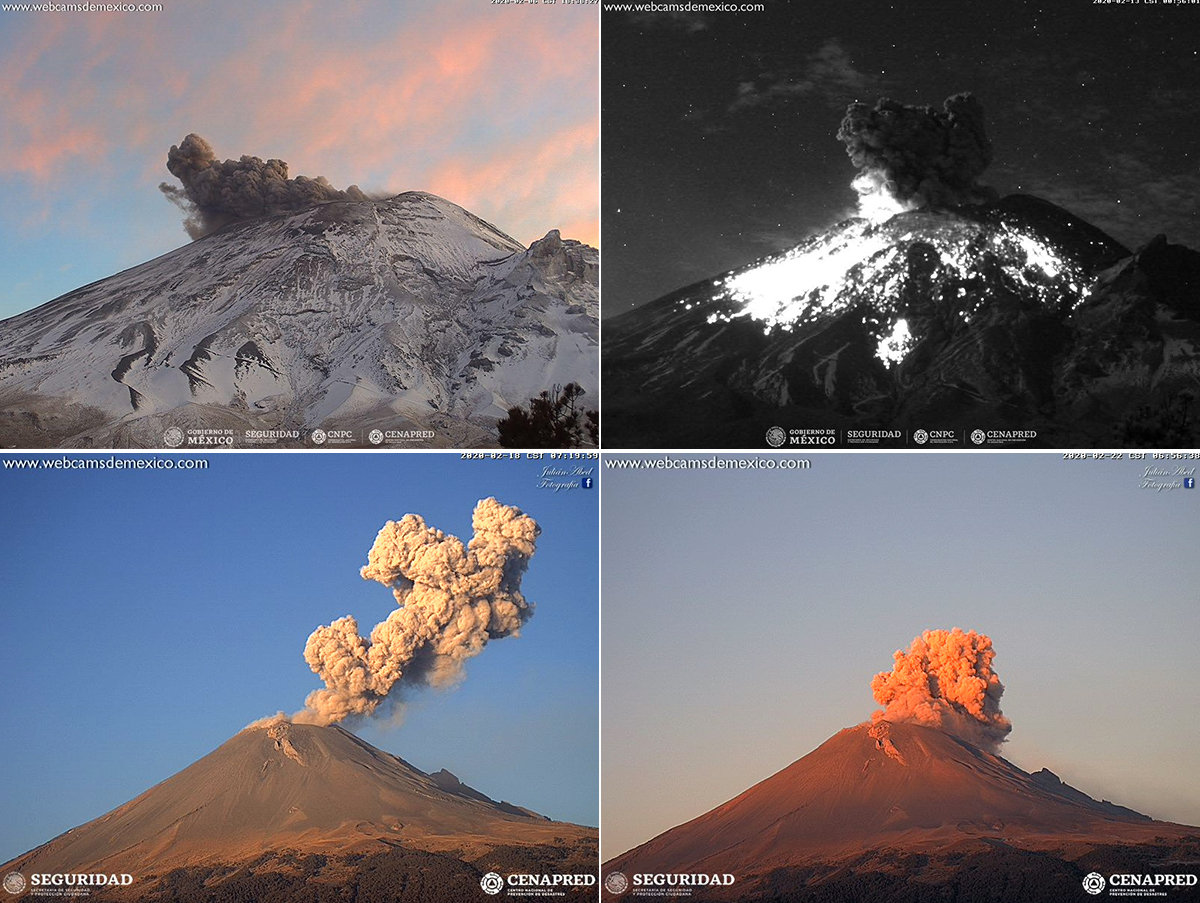Report on Popocatepetl (Mexico) — April 2020
Bulletin of the Global Volcanism Network, vol. 45, no. 4 (April 2020)
Managing Editor: Edward Venzke.
Edited by A. Elizabeth Crafford.
Popocatepetl (Mexico) Dome growth and destruction continues along with ash emissions and ejecta, September 2019-February 2020
Please cite this report as:
Global Volcanism Program, 2020. Report on Popocatepetl (Mexico) (Crafford, A.E., and Venzke, E., eds.). Bulletin of the Global Volcanism Network, 45:4. Smithsonian Institution. https://doi.org/10.5479/si.GVP.BGVN202004-341090
Popocatepetl
Mexico
19.023°N, 98.622°W; summit elev. 5393 m
All times are local (unless otherwise noted)
Frequent historical eruptions have been reported from Mexico's Popocatépetl going back to the 14th century. Activity increased in the mid-1990s after about 50 years of quiescence, and the current eruption, ongoing since January 2005, has included numerous episodes of lava-dome growth and destruction within the 500-m-wide summit caldera. Multiple emissions of steam and gas occur daily, rising generally 1-3 km above the summit at about 5,400 m elevation; many contain small amounts of ash. Larger, more explosive events with ash plumes and incandescent ejecta landing on the flanks occur frequently. Activity through August 2019 was typical of the ongoing eruption with near-constant emissions of water vapor, gas, and minor ash, as well as multiple explosions with ash plumes and incandescent blocks scattered on the flanks (BGVN 44:09). This report covers similar activity from September 2019 through February 2020. Information comes from daily reports provided by México's Centro Nacional de Prevención de Desastres (CENAPRED); ash plumes are reported by the Washington Volcanic Ash Advisory Center (VAAC). Satellite visible and thermal imagery and SO2 data also provide helpful observations of activity.
Activity summary. Activity at Popocatépetl during September 2019-February 2020 continued at the high levels that have been ongoing for many years, characterized by hundreds of daily low-intensity emissions that included steam, gas, and small amounts of ash, and periods with multiple daily minor and moderate explosions that produce kilometer-plus-high ash plumes (figure 140). The Washington VAAC issued multiple daily volcanic ash advisories with plume altitudes around 6 km for many, although some were reported as high as 8.2 km. Hundreds of minutes of daily tremor activity often produced ash emissions as well. Incandescent ejecta landed 500-1,000 m from the summit frequently. The MIROVA thermal anomaly data showed near-constant moderate to high levels of thermal energy throughout the period (figure 141).
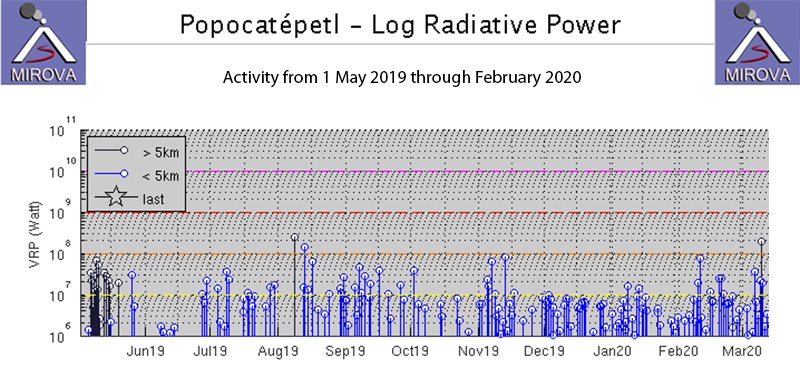 |
Figure 141. MIROVA log radiative power thermal data for Popocatépetl from 1 May 2019 through February 2020 showed a constant output of moderate energy the entire time. Courtesy of MIROVA. |
Sulfur dioxide emissions were measured with satellite instruments many days of each month from September 2019 thru February 2020. The intensity and drift directions varied significantly; some plumes remained detectable hundreds of kilometers from the volcano (figure 142). Plumes were detected almost daily in September, and on most days in October. They were measured at lower levels but often during November, and after pulses in early and late December only small plumes were visible during January 2020. Intermittent larger pulses returned in February. Dome growth and destruction in the summit crater continued throughout the period. A small dome was observed inside the summit crater in late September. Dome 85, 210-m-wide, was observed inside the summit crater in early November. Satellite imagery captured evidence of dome growth and ash emissions throughout the period (figure 143).
Activity during September-November 2019. On 1 September 2019 minor ashfall was reported in the communities of Atlautla, Ozumba, Juchitepec, and Tenango del Aire in the State of Mexico. The ash plumes rose less than 2 km above the summit and incandescent ejecta traveled less than 100 m from the summit crater. Twenty-two minor and three moderate explosions were recorded on 4-5 September along with minor ashfall in Juchitepec, Tenango del Aire, Tepetlixpa, and Atlautla. During a flyover on 5 September, officials did not observe a dome within the crater, and the dimensions remained the same as during the previous visit (350 m in diameter and 150 m deep) (figure 144). Ashfall was reported in Tlalmanalco and Amecameca on 6 September. The following day incandescent ejecta was visible on the flanks near the summit and ashfall was reported in Amecameca, Ayapango, and Tenango del Aire. The five moderate explosions on 8 September produced ash plumes that rose as high as 2 km above the summit, and incandescent ejecta on the flanks. Explosions on 10 September sent ejecta 500 m from the crater. Eight explosions during 20-21 September produced ejecta that traveled up to 1.5 km down the flanks (figure 145). During an overflight on 27 September specialists from the National Center for Disaster Prevention (CENAPRED ) of the National Coordination of Civil Protection and researchers from the Institute of Geophysics of UNAM observed a new dome 30 m in diameter; the overall crater had not changed size since the overflight in early September.
Fourteen explosions were reported on 2 October 2019. The last one produced an ash plume that rose 2 km above the summit and sent incandescent ejecta down the E slope (figure 146). Ashfall was reported in the municipalities of Atlautla Ozumba, Ayapango and Ecatzingo in the State of Mexico. Explosions on 3 and 4 October also produced ash plumes that rose between 1 and 2 km above the summit and sent ejecta onto the flanks. Additional incandescent ejecta was reported on 6, 7, 15, and 19 October. The communities of Amecameca, Tenango del Aire, Tlalmanalco, Cocotitlán, Temamatla, and Tláhuac reported ashfall on 10 October; Amecameca reported more ashfall on 12 October. On 22 October slight ashfall appeared in Amecameca, Tenango del Aire, Tlalmanalco, Ayapango, Temamatla, and Atlautla.
During 2-3 November 2019 there was 780 minutes of tremor reported in four different episodes. The seismicity was accompanied by ash emissions that drifted W and NW and produced ashfall in numerous communities, including Amecameca, Juchitepec, Ozumba, Tepetlixpa, and Atlautla in the State of México, in Ayapango and Cuautla in the State of Morelos, and in the municipalities of Tlahuac, Tlalpan, and Xochimilco in Mexico City. A moderate explosion on 4 November sent incandescent ejecta 2 km down the slopes and produced an ash plume that rose 1.5 km and drifted NW. Minor ashfall was reported in Tlalmanalco, Amecameca, and Tenango del Aire, State of Mexico. Similar ash plumes from explosions occurred the following day. Scientists from CENAPRED and the Institute of Geophysics of UNAM observed dome number 85 during an overflight on 5 November 2019. It had a diameter of 210 m and was 80 m thick, with an irregular surface (figure 147). Multiple explosions on 6 and 7 November produced incandescent ejecta; a moderate explosion late on 11 November produced ejecta that traveled 1.5 km from the summit and produced an ash plume 2 km high (figure 148). A lengthy period of constant ash emission that drifted E was reported on 18 November. A moderate explosion on 28 November sent incandescent fragments 1.5 km down the slopes and ash one km above the summit.
Activity during December 2019-February 2020. Throughout December 2019 weak emissions of steam and gas were reported daily, sometimes with minor amounts of ash, and minor explosions were only reported on 21 and 27 December. On 21 December two new high-resolution webcams were installed around Popocatépetl, one 5 km from the crater at the Tlamacas station, and the second in San Juan Tianguismanalco, 20 km away. Ash emissions and incandescent ejecta 800 m from the summit were observed on 25 December (figure 149). Incandescence at night was reported during 27-29 December.
Continuous emissions of water vapor and gas with low ash content were typical daily during January 2020. A moderate explosion on 9 January produced an ash plume that rose 3 km from the summit and drifted NE. In addition, incandescent ejecta traveled 1 km from the crater rim. A minor explosion on 21 January produced a 1.5-km-high plume with low ash content and incandescent ejecta that fell near the crater (figure 150). The first of two explosions late on 27 January produced ejecta that traveled 500 m and a 1-km-high ash plume. Constant incandescence was observed overnight on 29-30 January.
A moderate explosion on 5 February 2020 produced an ash plume that rose 1.5 km and drifted NNE. Explosions on 10 and 13 February sent ejecta 500 m down the flanks (figure 151). During an overflight on 18 February scientists noted that the internal crater maintained a diameter of 350 m and its approximate depth was 100-150 m; the crater was covered by tephra. For most of the second half of February the volcano had a continuous emission of gases with minor amounts of ash. In addition, multiple explosions produced ash plumes that rose 400-1,200 m above the crater and drifted in several different directions.
Geological Summary. Volcán Popocatépetl, whose name is the Aztec word for smoking mountain, rises 70 km SE of Mexico City to form North America's 2nd-highest volcano. The glacier-clad stratovolcano contains a steep-walled, 400 x 600 m wide crater. The generally symmetrical volcano is modified by the sharp-peaked Ventorrillo on the NW, a remnant of an earlier volcano. At least three previous major cones were destroyed by gravitational failure during the Pleistocene, producing massive debris-avalanche deposits covering broad areas to the south. The modern volcano was constructed south of the late-Pleistocene to Holocene El Fraile cone. Three major Plinian eruptions, the most recent of which took place about 800 CE, have occurred since the mid-Holocene, accompanied by pyroclastic flows and voluminous lahars that swept basins below the volcano. Frequent historical eruptions, first recorded in Aztec codices, have occurred since Pre-Columbian time.
Information Contacts: Centro Nacional de Prevención de Desastres (CENAPRED), Av. Delfín Madrigal No.665. Coyoacan, México D.F. 04360, México (URL: http://www.cenapred.unam.mx/), Daily Report Archive http://www.cenapred.unam.mx:8080/reportesVolcanGobMX/BuscarReportesVolcan); Washington Volcanic Ash Advisory Center (VAAC), Satellite Analysis Branch (SAB), NOAA/NESDIS OSPO, NOAA Science Center Room 401, 5200 Auth Rd, Camp Springs, MD 20746, USA (URL: www.ospo.noaa.gov/Products/atmosphere/vaac, archive at: http://www.ssd.noaa.gov/VAAC/archive.html); MIROVA (Middle InfraRed Observation of Volcanic Activity), a collaborative project between the Universities of Turin and Florence (Italy) supported by the Centre for Volcanic Risk of the Italian Civil Protection Department (URL: http://www.mirovaweb.it/); Global Sulfur Dioxide Monitoring Page, Atmospheric Chemistry and Dynamics Laboratory, NASA Goddard Space Flight Center (NASA/GSFC), 8800 Greenbelt Road, Goddard, Maryland, USA (URL: https://so2.gsfc.nasa.gov/); Sentinel Hub Playground (URL: https://www.sentinel-hub.com/explore/sentinel-playground).


